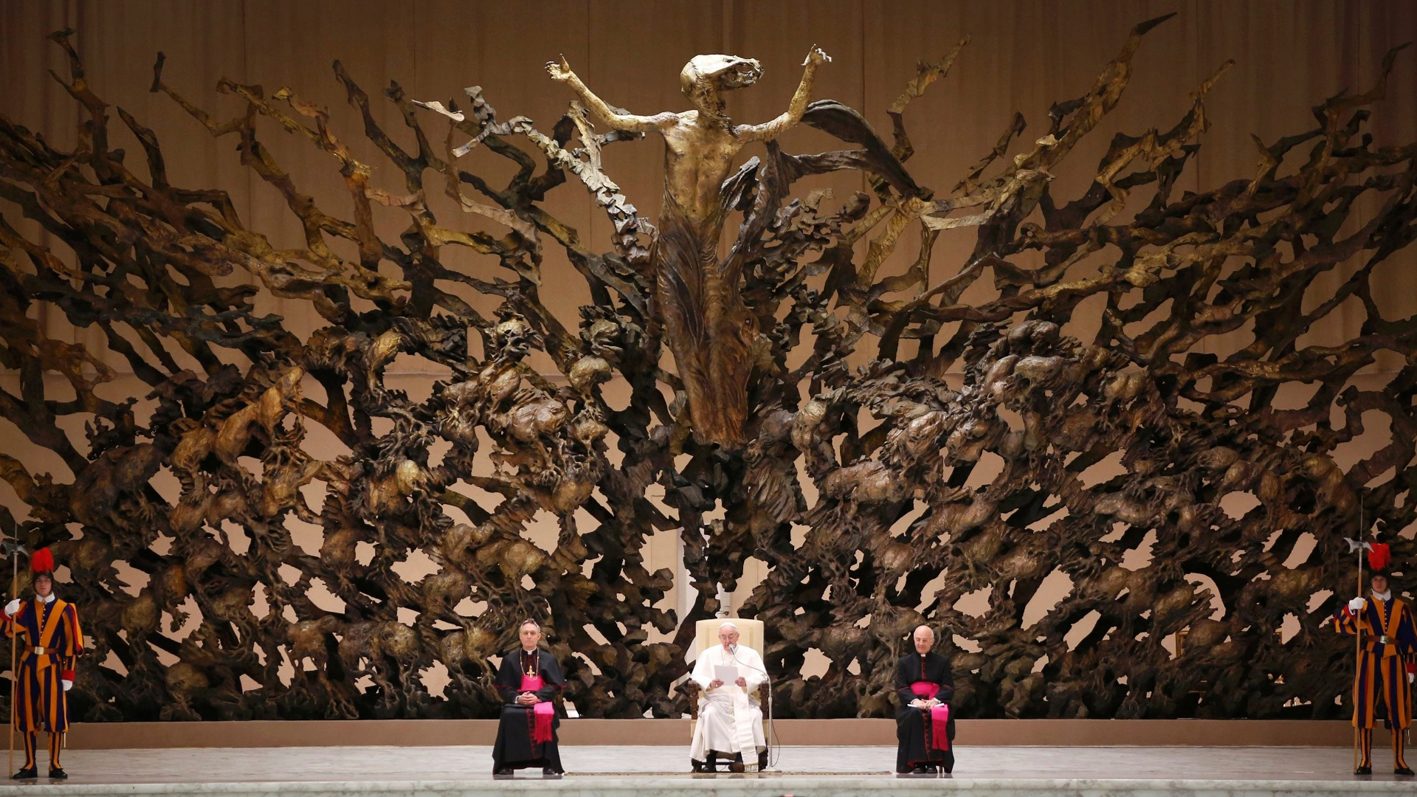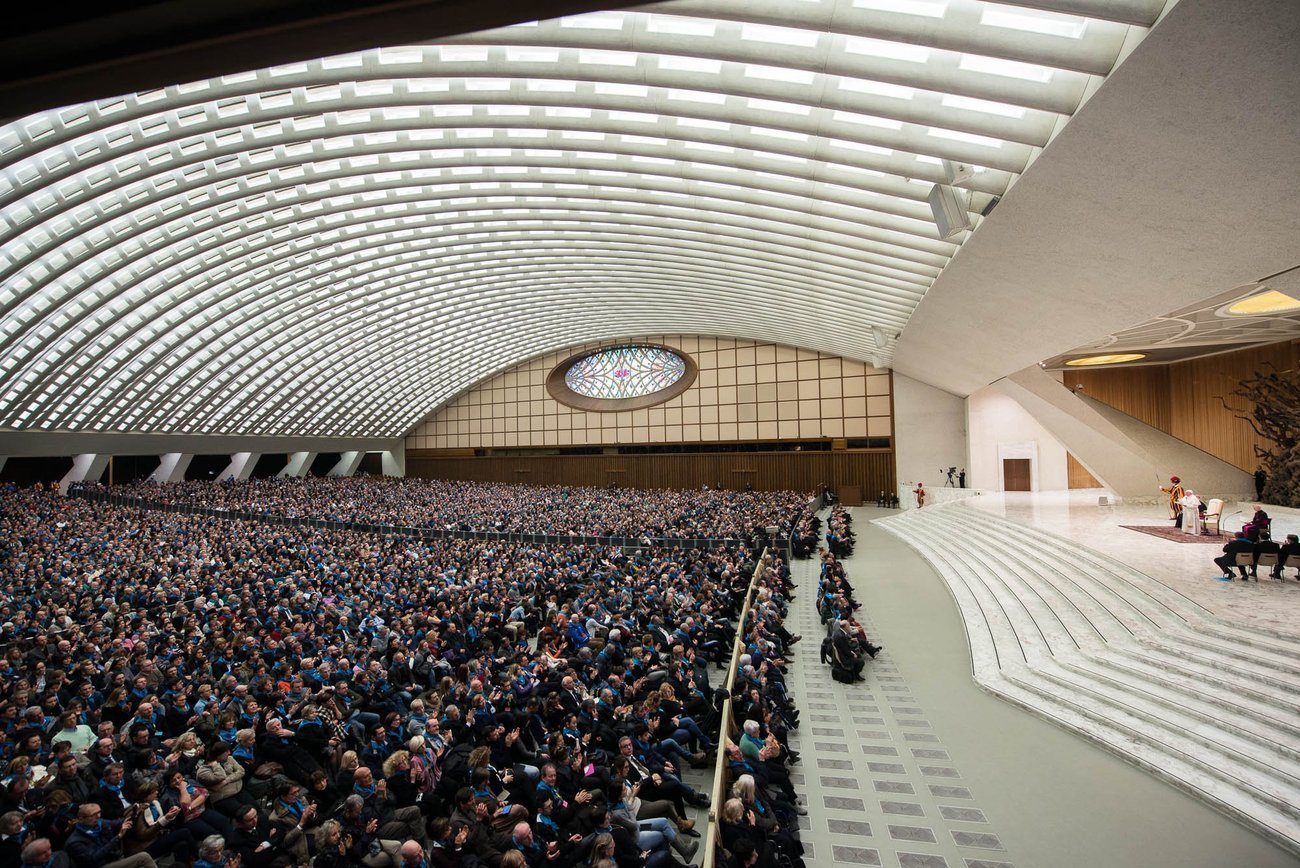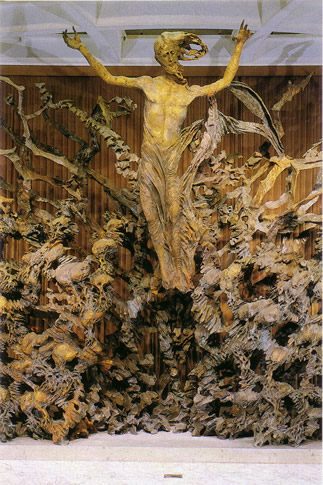{:it}Si nomini qualsiasi disciplina nel campo dell’arte e si scoprirà con facilità la contaminazione marchigiana. Le Marche hanno partorito donne e uomini che sono stati in grado di lasciare il segno nella storia delle arti, dall’antichità fino a tempi più moderni. Uno di questi è stato Pericle Fazzini, artista, scultore e pittore di grande prestigio internazionale. Una delle sue opere più famose è conservata nella rinomata Sala Nervi del Vaticano, si tratta di una delle sculture più visitate al mondo: La Resurrezione.
 L’opera
L’opera
La Resurrezione è una scultura in bronzo commissionata dall’allora Papa Paolo VI a Fazzini nel 1965 e poi terminata dallo scultore nel 1975, dopo cinque anni di lavoro consumati nella Chiesa di San Lorenzo in Piscibus a Roma. Il lavoro di Fazzini fu inaugurato nel settembre del 1977, alla presenza dello stesso Paolo VI. La sede scelta per la collocazione dell’opera fu niente di meno che l’Aula Nervi, la scenografica Sala Udienze del Vaticano, destinata al colloquio tra il Pontefice e il popolo: un segno indelebile delle radici marchigiane in un contesto esclusivo. Della larghezza di ben 20 metri, la statua è in grado di abbracciare l’intera sala, stupendo ogni presente con la sua austerità e nodosità. La Resurrezione infatti, tra i tanti temi cristiani affrontati nel corso dei secoli da pittori, scultori e gli artisti tutti, è il meno diffuso. In questo pezzo di straordinaria plasticità e forma, il Cristo è radioso, anche se si percepisce dallo sguardo ancora il dolore del sacrificio. Il Cristo è sorretto da forme che ricordano elementi del mondo naturale, un caos di radici e rami, un’esplosione, un Big Bang, la vita stessa. Le influenze barocche privilegiate da Fazzini sono percepibili, nonostante il mondo della materia e della plasticità sia padrone dell’opera.
 L’autore
L’autore
Definito dall’illustre Giuseppe Ungaretti “poeta del vento”, l’artista che è stato Pericle Fazzini ha, con il suo lavoro e il suo pensiero, irrimediabilmente graffiato il ‘900. Nacque a Grottammare, nelle Marche, nel 1913 e la sua formazione iniziò nella falegnameria di famiglia, per poi continuare nella capitale dove si trasferì per studio. Ciò che inspiegabilmente colpiva del suo lavoro era la facoltà di porsi un passo avanti alla tradizione, pur sempre rispettandola. Era però l’energia che i suoi lavori trasmettevano a convincere i mecenate, gli intenditori e successivamente il Vaticano, che il suo fosse un genio fuori dal comune e che, per questo, era necessario creare uno spazio nella storia. Nel corso della sua vita vinse numerosi concorsi illustri e partecipò a grandi eventi d’arte come la Biennale di Venezia con le sue sculture. Arrivò ad esporre fino in Giappone, entrando a pieno titolo nelle file internazionali e culminando poi con l’opera più grande: La Resurrezione. Dopo la sua morte, avvenuta nel 1987, la sua arte continua a vivere e, come il Cristo Risorto della sua scultura, a trasmettere la potenza rigeneratrice che rinnova costantemente l’essere e le sue manifestazioni, proprio come sosteneva Ungaretti.
«Il Cristo risorge da questo cratere apertosi dalla bomba nucleare: una atroce esplosione, un vortice di violenza e di energia» (Pericle Fazzini){:}{:en}
Whatever art branch you mention, you will easily discover influences by Marche artists. The region Marche gave birth to women and men who were able to have an impact on the history of arts, starting from the ancient times to the modern days. One of those was Pericle Fazzini: an internationally renowned artist, sculptor and painter. One of his most famous works exhibits at the well-known Sala Nervi in the Vatican City, it is one of the most visited sculptures in the world: The Resurrection.
The work
The Resurrection is a bronze sculpture commissioned by Pope Paul VI to Fazzini in 1965, completed by the sculptor in 1975 after five years of work at the Church of San Lorenzo in Piscibus in Rome. Fazzini’s work was inaugurated in September 1977 at the presence of Paul VI. The chosen seat for the work was the prestigious Aula Nervi, the spectacular Vatican’s Hall of the Pontifical Audiences used for meetings between the Pope and the faithful: a permanent sign of Marche traditions in an exclusive context. With its width of 20 meters, the sculpture embraces the whole Sala, and amazes everyone with its severity and entanglement. The Resurrection is actually the less common subject among the several Christian subjects chosen across the centuries by painters, sculptors and artists. In this unique piece of extraordinary plasticity and shape, Jesus is radiant, even though you can see on His face the pain for Sacrifice. Jesus rises among figures that remind natural elements, a chaos of roots and branches, an explosion a Big Bang, that is Life in itself. Baroque influences are privileged for Fazzini and you can see them, although matter and plasticity is the main character of the work.
The artist
Described by the eminent Giuseppe Ungaretti “poet of the wind”, Pericle Fazzini was an artist who irretrievably scraped the Twentieth century with his work and his thought. He was born in Grottammare in the region Marche in 1913 and as a boy, he started working at the family carpentry workshop, then moved to Rome to study. What is amazing of his work is the ability to move a step forward, even though he was actually able to respect tradition. Patrons, experts and later the Vatican were convinced by the energy that his works could impart, his genius was one of a kind, so that it was necessary to create a space in history. In his life, he won several prestigious contests and exhibited his sculptures at very important art events such as Venice Biennale. He exhibited also in Japan and entered international circuits until he created the greatest of his works: The Resurrection. After his death in 1987, his art lives again and just like Jesus rises in his sculpture, his works are able to spread the revitalizing power that constantly renovates the human being and his expressions, as Ungaretti would say.
«Jesus rises from a nuclear crater: a terrible explosion, a swirl of violence and energy» (Pericle Fazzini){:}


1 commento
[…] il Palazzo della Cancelleria, dove il prelato gli aveva comunicato che avrebbe dovuto rappresentare La Resurrezione. Dopodiché, era stato parcheggiato nella sala d’aspetto di una tipografia come un […]